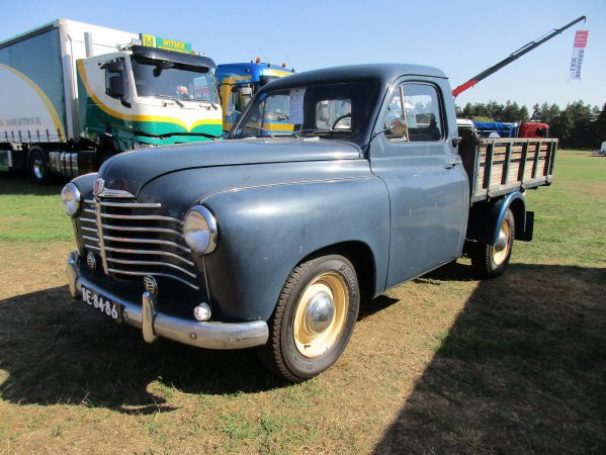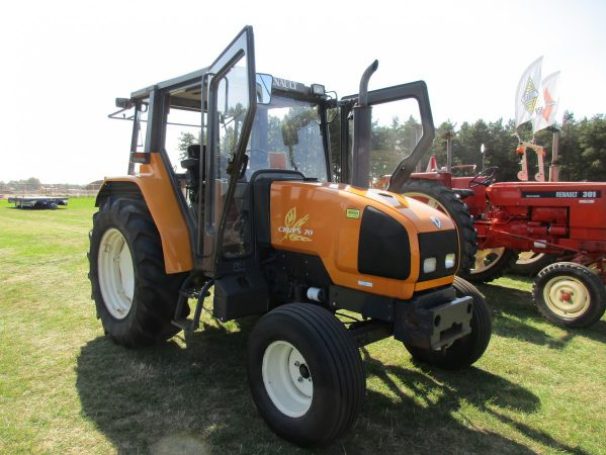A vehicle manufacturer. That’s the best way to describe the Renault company, founded in 1899 by Louis, Marcel and Fernand Renault. A solid collection of old, recent and new cars was present at the recently held 2016 Renaultoloog Festival.
But there was much more to explore, as we will see in part two of the tour along the diamond badged self-propelled vehicles.
Let’s start with the vans. A Renault specialty, without any doubt. Like this fine 1985 Renault 4 F6 panel van.
And its successor, the Renault Express. Introduced in 1985 and based on the 2nd generation of the Renault 5. Pictured a 1st generation Express, built from 1985 to 1991.
This little trailer is based on a Renault Express. Not self-propelled, but too nice to leave out.
There was a very satisfactory number of Estafettes at the event. The FWD Renault Estafette was introduced in 1959, above a 1976 Renault Estafette 1000.
Another Estafette from 1976.
And then suddenly it’s 2016. Here’s a RWD (with dual rear wheels) Renault Master, owned by a gardening company. It’s powered by a 2.3 liter 4-cylinder diesel engine. The Opel~Vauxhall Movano and Nissan NV400 are rebadges of the Renault Master. So GM does offer a direct Ford Transit and Mercedes-Benz Sprinter competitor; not in North America though.
This is an example of a FWD Renault Master, it has the 150 hp version of the 2.3 liter diesel engine. Needless to say it’s owned by a Harley Davidson specialist. I think we can all agree that this is a typical full-size van.
Refrigerated Renault Master.
It’s a small step from a FWD van, certainly if it has a raised roof, to a campervan. Above a 1970 Renault Estafette 1000.
1971 Saviem Super Goélette SG2. In 1955 Renault’s heavy vehicles division merged with Somua and Latil, the new truck- and bus manufacturer’s name was Saviem. In 1959 Renault became Saviem’s sole shareholder.
The Super Goélette, introduced in 1965, was built by Saviem. From 1965 to 1970 it was sold as a Renault, and from 1971 to 1980 as a Saviem.
This is a 1968 Super Goélette SG2, so marketed as a Renault.
Striking compact motorhome, based on a 1966 Renault Estafette.
1984 Dodge Renault S56 with a 3.8 liter 4-cylinder Perkins diesel. As we all know Chrysler pulled out of all their Euro-operations in 1978, selling them to Peugeot. However, Chrysler’s UK production facility for heavy vehicles ended up in the hands of Renault, as Peugeot was not interested in this segment. The original Dodge 50-series was introduced in 1979.
This van’s camper conversion was done in 1997. It can be yours for € 4,450.
Rimor Koala 722 Elite semi-integrated motorhome, an Italian product. Built on a French Renault Master. And with Belgian plates.
Back to the workhorses with a 1954 Renault Colorale flatbed truck, powered by a 1,966 cc 4-cylinder gasoline engine.
1970 Renault Estafette 1000 in Miller Brewing Company livery. Cheers !
Renault 4 Pick-up. And no one will ever complain that its bed is too tall.
1981 Renault JK 65 (6.5 metric ton GVM) with the Club of Four cab. The cab was developed by DAF, Saviem, Volvo and Magirus-Deutz in the early seventies. The truck is powered by a 3.6 liter 4-cylinder diesel engine.
Berliet was a French manufacturer of cars, trucks, buses and military vehicles. The company was founded in 1899 by Marius Berliet (1866-1948). Renault bought Berliet in 1974, interesting to know is that Citroën owned Berliet from 1967 to 1974. In 1978 Saviem and Berliet merged into Renault’s RVI (Renault Véhicules Industriels) division.
The tractor above is a 1974 Berliet TR280. This series of heavy-duty cabover trucks and tractors was introduced in 1971. Ford Europe used the highly modern Berliet cab for the big 1975-1984 Ford Transcontinental.
280 ch (cheval-vapeur) means that there’s a maximum of 280 horses at work.
Et voilà, from Berliet to Renault. The R-series was built until 1996. Pictured a Renault R 385 ti Major, the last 1990-1996 generation of the R-series.
A very rare sight in Northwestern Europe, the conventional Renault C-series with the Club of Four cab. This tractor is a CBH 440.
Can power be a sin ? That’s the question (on the tractor’s hood). Must be a variation on Zarah Leander’s Kann denn Liebe Sünde sein ? from the thirties. The things you learn when posting a picture of a heavy-duty Renault tractor on CC…
2008 Renault Premium 450 tractor, powered by a 10.8 liter 6-cylinder engine (450 hp).
One of the most extraordinary cabovers ever, in my opinion. The Renault Magnum, originally known as the Renault AE, was introduced in 1990. The engine doesn’t intrude into the cab, the cab’s floor is fully flat. The whole cab structure is literally on top of things.
From the days that Renault owned Mack, this Magnum with a 560 hp Mack V8 engine. Since 2012 Volvo fully owns Renault Trucks, which means that Volvo also fully owns Mack.
Ja, ja, genau ! The production of the Renault Magnum ended in 2013.
Renault’s current truck top model, the T-series, is heavily based on the Volvo FH-series. The top engine is a 520 hp 12.8 liter 6-cylinder.
Renault offers the C- and K-series trucks for harsh conditions and rough terrain. Above a 2015 Renault K 6×6 rally raid assistance truck for the Mammoet Rallysport team.
And this 2015 Renault C. The 2nd and 3rd axle are drive axles, the 4th axle is liftable.
The sky is the limit.
Renault also built farm tractors, Renault Agriculture was founded in 1918. Between 2003 and 2008 Renault sold the company to Claas, the German manufacturer of agricultural machinery.
The most recent Renault farm tractor at the show was this Ceres 70. A mid-nineties tractor model with a 3-cylinder MWM engine.
And with this little creature, a 2012 Renault Twizy electric city car, the show comes to an end. And what a great pleasure it was to be there !







































































Wow, quite a variety. I will confess that I continue to struggle with the aesthetic of the tall, narrow, chiseled look of European vans. Truthfully, the 1954 Colorale flatbed is more in line with my idea of what a truck should look like. However, I understand the conditions in Europe that placed a premium on height and space efficiency, and with those trucks now coming here in large volumes, I will just have to get used to them.
I did not know that Renault had such a long history in farm equipment.
Cargasm 2.
Interesting to note the common points with cars. The early Estafette has a Dauphine dashboard, the late Estafette has an R8 dashboard. The ancient tractor is built the same way as the first Renault cars, with radiator behind the engine and sloping hood. Recognizable even without the huge diamond.
Lots of great stuff there, but that Dodge Renault S56 really caught my attention.I recognize those front fenders! It uses parts of the body of the US Dodge van (B series). But obviously, it sits on a full ladder frame, unlike the unitized American van.
I did some more Googling of this vehicle; it appears that only a relatively small percentage used the US van cab, to one degree or another. But I found two that do, including a motorhome that looks incredibly similar to tens of thousands of Dodge-based Class C motorhomes from the era. But of course, the Dodge Renault has a diesel engine.
And here’s a fire truck, from the UK:
There was a variety of vehicles from the Chrysler UK break-up that finished with Renault badges. The Commer Commando, which was also sold as a Dodge for a while, ended up as a Renault too.
The Renault magnum trucks.
I can still remember the first time I saw one, as oncoming traffic on the Antwerp Ring road, the big white cab looked like a driving skyscraper, I nearly crashed my car as I turned my head because I could not believe what I just seen.
I mean we did have space-cabs on our European cab over trucks but nothing, really nothing looked like this thing !
They were right, everything you buy today for the long haul, from Mercedes to Scania from MAN to DAF, all have this cab configuration.
The French, as oftern, were lightyears ahead and they really split the power-engine part from the working space, this cab was not a part of, but connected to the chassis to get a better ride.
I remember a Scottish driver delivering goods to our company on a saturday morning, he was not a tall guy and he could stand right up in the door opening !
He was on his third AE or Magnum and was hooked on them ! Called it his mobile living room.
AE, the introduction name for these trucks stands for Alliance Européenne, or European Alliance, we all thought the EU would be a hughe success back in the nineties! LOL !
Later Magnum, the name of the most luxurious AE model became the name we used for this truck.
its successor looks well uuh strange to say the least !
SILENCE! The AE Magnum is coming!
About the Express: The damn things were like cockroaches in the early 00’s, but faded really quickly. The nose job was good to the point that took me a L O T to realize they were based off the R5. Now the cockroaches in the delivery market are the Kangoos, which people seem to like. And having ridden in a late-model one, they are so much nicer to be in than the Express (expresses????) were.
The Saviem trucks were licence built by the Czech(oslovakian) Avia firm, previously making aeroplanes and such. Those trucks were a common sight, especially as flatbed trucks.
Afterwards in the 1990’s, when Daewoo acquired a lot Central and Easter European factories it was still being sold as Daewoo Avia, but with a really ugly plastic panel tacked on the front.
http://www.24valve.com/czech_trucks.htm
What a range!
Tough call between the Miller brewing Estafette or the Magnum.
The Dodge 50 (nee S56) wasa common sight in the UK in the 1980s
The Renault/Mack trucks are familiar and there are a few Movanos over here but most of these commercials are either unknown or rare in this part of the world, I drove a CH Mack concrete mixer for a while everything on it inside had a Renault symbol.
I really like the van based RV’s. I have never seen any of the old ones up here in Canada. Except for the occasional new ones sporting EU plates going down the island highway here on Vancouver island. They seem to be coming down by ferry from Alaska via prince Rupert to port Hardy (on the north of the Island). I have always wanted to do that trip but it is currently beyond my meager budget…
I think I saw the Renault JK65 truck as a Mack here in the US with round lights.
The Club of Four cab was also used by Mack. Both as cabover and conventional.
I like those chunky-looking Magnum cabs, but Renault Colorale for me please. Caught this recently…
Love that light green on the 2008 Renault Premium. Very Dutch color & one you nrver see on this side of the pond.
I like the one hat looks a bit like the VW Samba, with the windows on the roof.
Great post – really enjoyed all the big rigs – that CBH 440 is a tough looking truck.
Yep, that conventional model was developed and built for tough jobs, like working on construction sites. Just like the current C- and K-series (the Mammoet Rallysport trucks in the article).
Most truckmakers offer extra-heavy-duty trucks for that kind of work. Like the Iveco Trakker and Volvo FMX.